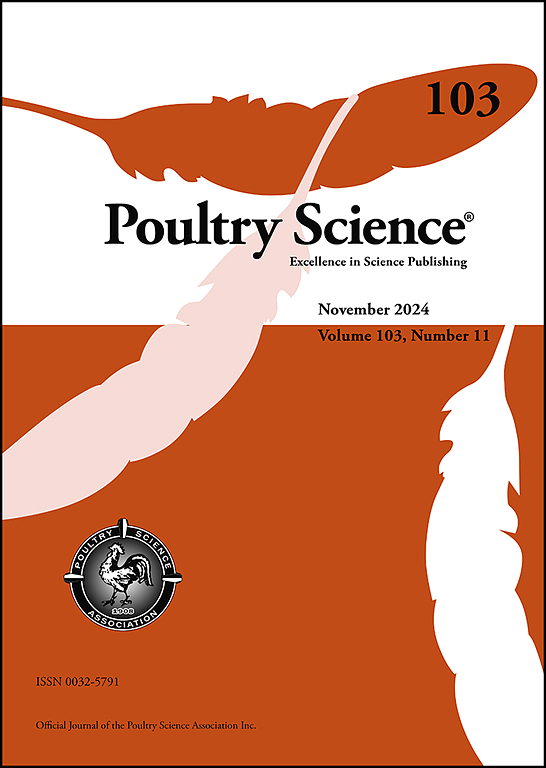Unraveling the regulatory mechanisms of fasting-induced molting on follicle development in laying hens
IF 4.2
1区 农林科学
Q1 AGRICULTURE, DAIRY & ANIMAL SCIENCE
引用次数: 0
Abstract
Fasting-Induced Molting (FIM) has been shown to enhance the laying rate and extend the laying cycle of hens in the late laying period. However, the precise regulatory mechanism underlying FIM’s effects on follicle development remains unknown. This study aimed to elucidate these mechanisms by utilizing RNA-seq to analyze the gene expression changes during FIM and identify the key genes involved in follicle development, thereby uncovering the molecular pathways through which FIM exerts its regulatory effects. A total of 96 Houdan hens, aged 326 days, were selected for FIM treatment. The results indicated a progressive increase in the number of small white follicles, as well as primary and secondary follicles, during the fasting and recovery phases. Serum levels of follicle-stimulating hormone (FSH), luteinizing hormone (LH), and anti-Müllerian hormone (AMH) were reduced during the fasting period but gradually rebounded during refeeding. RNA sequencing and real-time quantitative PCR (qRT-PCR) analyses identified the PI3K-AKT signaling pathway as a crucial regulator of ovarian remodeling. Protein-Protein Interaction (PPI) analysis revealed that genes from the collagen family, particularly COL1A1, exhibit strong connectivity. In vitro experiments on cultured ovaries treated with varying concentrations of COL1A1 revealed that COL1A1 promotes ovarian cell proliferation, activates the PI3K-AKT signaling pathway, and upregulates the expression of GDF9 and BMP4. Masson staining results revealed significant collagen deposition in the ovary at the onset of FIM (F0), which was markedly reduced at F15. Collagen deposition re-emerged during the later stages of refeeding. In conclusion, this study identified the key genes regulating follicle development during the FIM and demonstrated that FIM can alleviate ovarian collagen deposition. These findings elucidate the molecular mechanism underlying FIM’s regulatory effects on follicle development, providing a theoretical foundation for enhancing ovarian function in laying hens and optimizing FIM protocols.
研究蛋鸡断食诱导换羽对卵泡发育的调控机制
禁食诱导换羽(FIM)可以提高蛋鸡产蛋后期的产蛋率和延长产蛋周期。然而,FIM对卵泡发育影响的确切调控机制尚不清楚。本研究旨在通过RNA-seq分析FIM过程中基因表达的变化,鉴定参与卵泡发育的关键基因,从而揭示FIM发挥其调控作用的分子途径,从而阐明这些机制。选取96只326日龄的后单蛋鸡进行FIM处理。结果表明,在禁食和恢复阶段,小白色卵泡以及原发性和继发性卵泡的数量逐渐增加。血清促卵泡激素(FSH)、黄体生成素(LH)和抗勒氏杆菌激素(AMH)水平在禁食期间降低,但在再饲喂期间逐渐回升。RNA测序和实时定量PCR (qRT-PCR)分析发现,PI3K-AKT信号通路是卵巢重塑的重要调节因子。蛋白质-蛋白质相互作用(PPI)分析显示,胶原蛋白家族的基因,特别是COL1A1,表现出很强的连通性。不同浓度COL1A1对体外培养卵巢的实验表明,COL1A1可促进卵巢细胞增殖,激活PI3K-AKT信号通路,上调GDF9和BMP4的表达。Masson染色结果显示,FIM开始时卵巢内有明显的胶原沉积(F0), F15时明显减少。胶原蛋白沉积在补饲后期再次出现。综上所述,本研究确定了FIM过程中调节卵泡发育的关键基因,并证明FIM可以减轻卵巢胶原沉积。这些发现阐明了FIM调控卵泡发育的分子机制,为增强蛋鸡卵巢功能和优化FIM方案提供了理论基础。
本文章由计算机程序翻译,如有差异,请以英文原文为准。
求助全文
约1分钟内获得全文
求助全文
来源期刊

Poultry Science
农林科学-奶制品与动物科学
CiteScore
7.60
自引率
15.90%
发文量
0
审稿时长
94 days
期刊介绍:
First self-published in 1921, Poultry Science is an internationally renowned monthly journal, known as the authoritative source for a broad range of poultry information and high-caliber research. The journal plays a pivotal role in the dissemination of preeminent poultry-related knowledge across all disciplines. As of January 2020, Poultry Science will become an Open Access journal with no subscription charges, meaning authors who publish here can make their research immediately, permanently, and freely accessible worldwide while retaining copyright to their work. Papers submitted for publication after October 1, 2019 will be published as Open Access papers.
An international journal, Poultry Science publishes original papers, research notes, symposium papers, and reviews of basic science as applied to poultry. This authoritative source of poultry information is consistently ranked by ISI Impact Factor as one of the top 10 agriculture, dairy and animal science journals to deliver high-caliber research. Currently it is the highest-ranked (by Impact Factor and Eigenfactor) journal dedicated to publishing poultry research. Subject areas include breeding, genetics, education, production, management, environment, health, behavior, welfare, immunology, molecular biology, metabolism, nutrition, physiology, reproduction, processing, and products.
 求助内容:
求助内容: 应助结果提醒方式:
应助结果提醒方式:


